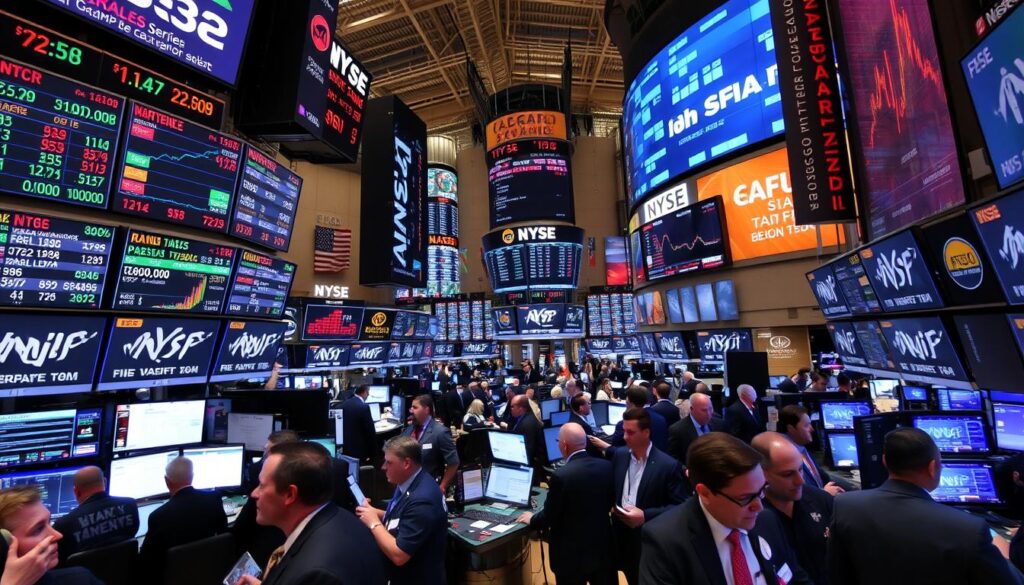Did you know the global stock market is worth a whopping $100 trillion? This huge financial world has shaped our economy for centuries. Yet, many of its amazing facts are still unknown. As beginner investors and those interested in finance, let’s explore the stock market’s history together. We’ll discover 15 incredible facts that will change how you see this exciting field.
Key Takeaways
- The stock market is key to the global economy, worth over $100 trillion.
- Knowing the basics, like investment strategies for beginners, is vital for starting your investment journey and growing wealth over time.
- Investing basics for beginners include learning about bulls and bears, the history of stock tickers, and the effects of events like the Flash Crash.
- A beginner’s guide to investing shows how important financial knowledge, smart money handling, and keeping up with market trends are.
- To succeed in the stock market, you need to mix investment fundamentals with investing 101 knowledge. This way, you can use wealth building strategies effectively.
The First Stock Exchange: A 17th Century Invention
The history of financial markets goes back to the 17th century. The world’s first official stock exchange was set up in Amsterdam, Netherlands. The Amsterdam Stock Exchange, started in 1602, was a big step in the growth of the global stock market.
The Dutch East India Company, one of the first public companies, played a key role. In the early 17th century, it sold shares to fund its global trade. These shares were traded on Amsterdam’s streets, leading to a central market for buying and selling securities.
The Historical Development of Stock Trading
The Amsterdam Stock Exchange’s success inspired other financial centers. Places like the London Stock Exchange and the New York Stock Exchange followed its lead. The exchange’s use of short-selling and futures contracts became common worldwide.
| Year | Event | Impact |
|---|---|---|
| 1602 | Establishment of the Amsterdam Stock Exchange | First official stock exchange in the world |
| 1611 | Introduction of short-selling and futures contracts | Pioneered innovative trading practices |
| 1698 | Establishment of the London Stock Exchange | Modeled after the Amsterdam exchange |
The Amsterdam Stock Exchange’s role in history is huge. It was the first official stock exchange, setting the stage for today’s financial markets. Its early innovations still shape how stock markets work today.
NYSE’s Origins: The Buttonwood Tree Agreement
The New York Stock Exchange (NYSE) started in 1792. On that day, 24 stockbrokers and merchants met under a buttonwood tree on Wall Street. They signed the Buttonwood Agreement, starting the NYSE and setting the stage for the world’s biggest stock exchange.
The Buttonwood Agreement was a key document. It set rules for trading securities. It also said brokers had to charge certain fees and trade on Wall Street’s “Wall Street curb.” This agreement was the start of the New York Stock Exchange history and Wall Street origins.
The Buttonwood Agreement marked a big moment for the New York Stock Exchange. It was the start of a journey that made the exchange a global financial leader. It became a symbol of the American economy’s strength and resilience.
“The Buttonwood Agreement was a humble start, but it laid the foundation for the NYSE’s rise to become the world’s largest and most prestigious stock exchange.”
The Buttonwood Agreement changed over time. In 1817, stockbrokers formed the New York Stock & Exchange Board, which became the NYSE. This helped standardize trading and attract more investors.
Today, the Buttonwood Agreement is seen as a key moment in financial history. It shows the NYSE’s journey to global fame. The humble start under the buttonwood tree shows Wall Street’s resilience and entrepreneurial spirit.
The Symbolism of Bulls and Bears
In the world of financial markets, two symbols are key: the bull and the bear. These symbols tell us about the market’s mood. They show the psychology of those who invest in stocks.
The bull market is like a bull attacking, pushing things up. It means the market is doing well and people are hopeful. On the other hand, the bear market is like a bear swiping down. It shows a market that’s falling and people are worried.
These financial market terminology are common in stock market psychology. They help investors and analysts talk about the market’s mood. They use these terms to share the current feelings and trends in the markets.
Knowing what these symbols mean can help investors. It lets them understand the market’s ups and downs. By getting the stock market psychology behind these terms, they can make smarter choices. They can also get ready for when the market changes from bull to bear.
| Bull Market | Bear Market |
|---|---|
| Represents an optimistic, thriving market | Represents a pessimistic, declining market |
| Symbolized by an upward thrust, like a bull’s horns | Symbolized by a swiping downward motion, like a bear’s paw |
| Indicates a market that is generally rising in value | Indicates a market that is generally declining in value |
Stock Tickers: 19th Century Innovation
Before digital tech changed finance, stock prices were shared through clever telegraph and ticker tape machines. This financial technology was key in shaping today’s stock exchanges.
The stock ticker started in the 1860s. It let traders get updates on market actions in real-time. These machines printed stock info on long, thin strips of paper, called ticker tape. This gave traders instant access to market news.
The telegraph systems behind these ticker tape machines changed info sharing. Before, traders had to wait for old or second-hand prices. The ticker tape system made it possible for traders to act fast with the latest data.
This innovation greatly impacted the stock market. It made trading faster and gave investors timely info. The stock tickers became crucial, laying the groundwork for today’s finance world.
“The stock ticker was a game-changer, connecting traders across the country and ushering in a new era of market transparency.”

Looking back at financial tech history, the stock ticker shows the creativity and innovation in the stock market’s growth. Its influence still shapes our understanding of finance today.
The Flash Crash of 2010: A Cautionary Tale
The stock market has seen many dramatic moments, but the flash crash of 2010 stands out. On May 6th, 2010, the Dow Jones Industrial Average dropped nearly 1,000 points in minutes. Then, it quickly recovered most of those losses. This event showed how automated trading systems can fail and how market volatility can get out of hand.
The flash crash was both shocking and worrying. It started with a big sell order, causing a chain reaction. Automated trading algorithms bought and sold fast, making the market drop even more. The quick fall and unclear information caused panic among investors, raising big questions about market stability.
After the flash crash, regulators and market players had to face the dangers of automated trading systems. This event taught us a hard lesson. It showed we need strong protections and a better understanding of today’s financial markets.
The financial world keeps changing, and the flash crash of 2010’s lessons are still important. By learning from this event, we can make the stock market more stable. This way, investors and policymakers can help the stock market stay a key part of the global economy.
Warren Buffett’s Million Dollar Bet
In 2008, Warren Buffett made a bold bet that caught everyone’s attention. He wagered $1 million that a simple, low-cost index fund would outperform a group of hedge funds over ten years. This bet showed Buffett’s strong belief in long-term investment strategies.
The bet was between Buffett’s belief in passive investing and the skills of active hedge fund managers. Buffett believed that most of these managers would not beat the market. He thought a simple S&P 500 index fund would give better returns over time.
| Investment Approach | 10-Year Performance (2008-2017) |
|---|---|
| S&P 500 Index Fund | +125.8% |
| Hedge Fund Selection | +85.4% |
In 2017, the results were in, and Buffett won. The S&P 500 index fund beat the hedge funds, returning 125.8% to their 85.4% over ten years.
“Consistently investing in an index fund is the soundest way to achieve good returns over long periods of time.”
Buffett’s win proved his investment philosophy right. It showed that a simple, low-cost index fund investing strategy works. Even against the complex and actively managed hedge funds.
Buffett’s million-dollar bet still inspires investors today. It teaches patience, diversification, and focusing on long-term results. As finance changes, Buffett’s win reminds us that sometimes, the simplest way is the best.
Beginner Investor Tips: Stock Market Predictions and Elections
For new investors, understanding the stock market and elections can be tough. But knowing about the “Presidential Election Stock Market Indicator” can help. It gives clues about market trends and how to invest.
This theory says the S&P 500’s performance before a presidential election can show who will win. If the market goes up, the current party usually stays in power. But if it goes down, the other party might win. Since 1928, this indicator has been right about 87% of the time.
Even so, the stock market is influenced by many things. This includes the economy, company earnings, and world events. Relying only on this indicator is risky. Beginner investors should look at more than just this to make smart choices.
For new investors, it’s better to diversify their portfolio. This means investing in different types of assets. Stocks, bonds, and more, based on what they can handle and their goals. This way, they can deal with the stock market and elections more confidently.
“Investing is not a game of perfect. It’s a game of probabilities, and you have to make decisions based on what you know and what you don’t know.”
The Santa Claus Rally: A Seasonal Phenomenon
The stock market has a special trend called the “Santa Claus Rally.” It happens in the last five trading days of December and the first two of January. This trend is often seen as a sign of good times ahead, thanks to the holiday spirit.
Many studies have looked into why this happens. Some reasons include:
- Holiday bonuses and extra money from investors
- The joy and hope of the holiday season
- Less trading during the holidays, making big moves stand out
Let’s dive into some important numbers:
| Year | Santa Claus Rally Performance | Seasonal Stock Market Trends |
|---|---|---|
| 2020 | +1.8% | +3.2% |
| 2019 | +1.6% | +2.9% |
| 2018 | -0.4% | -0.8% |
The data shows the Santa Claus Rally often brings good news. But, it’s key to remember that the market can change quickly. Always think carefully before investing.
“The Santa Claus rally is a fascinating seasonal trend that has captivated investors for decades. While it may not be a surefire bet, understanding the potential drivers behind this phenomenon can provide valuable insights into the broader dynamics of the stock market.”
In summary, the Santa Claus Rally is a special part of the stock market. It shows how investor feelings and the market work together. By staying informed, investors can use this trend wisely, keeping their investments balanced and diverse.

Circuit Breakers: Preventing Extreme Volatility
Stock markets can be unpredictable and volatile. This can cause panic and instability. To tackle this, market authorities use circuit breakers. These tools are key to keeping the market stable and protecting investors from stock market volatility.
The 10% Circuit Breaker
The “10% Rule” is a common circuit breaker. It stops trading if the S&P 500 index drops by 10% in one day. This circuit breaker gives the market a chance to calm down. It prevents a big drop in the market caused by panic selling.
The 10% circuit breaker is a vital safety net. It helps investors think clearly and make smart choices, not rush into decisions. This 10% rule is a key tool for regulators. It helps keep the market stable and reduces the risks of stock market volatility.
“Circuit breakers are designed to provide a cooling-off period during times of extreme market stress, allowing investors to reassess their positions and make more informed decisions.”
The stock market keeps changing and facing new issues. Circuit breakers are still very important for the financial system’s health. By knowing about the 10% rule and its role in market stability, everyone can better understand the stock market. This helps create a more stable and safe place for investing.
Conclusion: Navigating the Fascinating World of Stock Markets
The stock market’s history is both captivating and complex. It started in the 17th century in Amsterdam and has evolved since. Today, it includes flash crashes and cryptocurrency innovations. Exploring its stock market insights helps us understand its evolution.
By learning about the stock market’s history, we gain valuable knowledge. This knowledge helps us make better investment choices. It also teaches us about the importance of financial literacy and wealth building.
Investors who understand these facts can make smarter decisions. They can handle market ups and downs better. The stock market is a place of endless learning and growth, shaping our financial futures.


